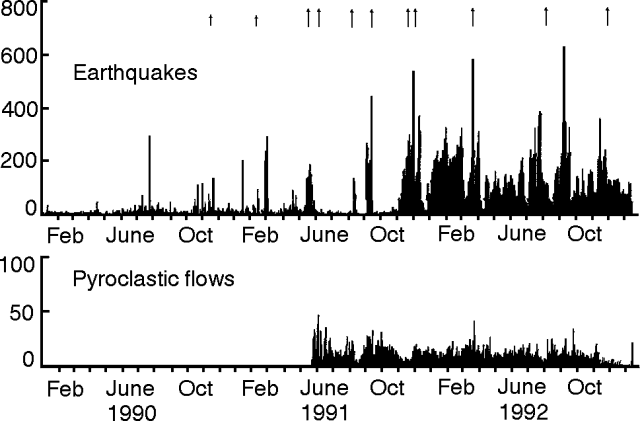Report on Unzendake (Japan) — December 1992
Bulletin of the Global Volcanism Network, vol. 17, no. 12 (December 1992)
Managing Editor: Lindsay McClelland.
Unzendake (Japan) Continued dome growth; brief burst of vigorous pyroclastic flows
Please cite this report as:
Global Volcanism Program, 1992. Report on Unzendake (Japan) (McClelland, L., ed.). Bulletin of the Global Volcanism Network, 17:12. Smithsonian Institution. https://doi.org/10.5479/si.GVP.BGVN199212-282100
Unzendake
Japan
32.761°N, 130.299°E; summit elev. 1483 m
All times are local (unless otherwise noted)
A new lava dome (dome 9) began to emerge in the central part of the complex on 3 December. The frequency of seismically detected pyroclastic flows had declined in mid-November and remained low through December. Only 86 pyroclastic flows were recorded in December, down from 255 in November and 300-500 in the previous months (table 11). Pyroclastic flows moved mainly towards the SE . . . and E . . . . Most traveled 1-2 km, although the largest flow advanced E ~ 3 km on 20 December at 0926, with a seismic duration of 170 seconds. Ash clouds from the flows rose ~ 0.5-1 km during December, causing ashfalls on inhabited areas.
Table 11. Monthly seismicity and number of seismically recorded pyroclastic flow events at Unzen, 1992. Courtesy of JMA.
| Month | Earthquakes | Pyroclastic flows |
| Jan 1992 | 5337 | 308 |
| Feb 1992 | 6423 | 344 |
| Mar 1992 | 5623 | 504 |
| Apr 1992 | 3053 | 332 |
| May 1992 | 3234 | 337 |
| Jun 1992 | 3671 | 373 |
| Jul 1992 | 5614 | 342 |
| Aug 1992 | 3125 | 357 |
| Sep 1992 | 5947 | 395 |
| Oct 1992 | 2948 | 286 |
| Nov 1992 | 4864 | 255 |
| Dec 1992 | 3558 | 86 |
Small earthquakes beneath and within the dome complex continued to occur at high rates, declining slightly in late December. Daily numbers ranged from 60 to 180 (figure 47). A total of 3,558 occurred in December . . . (table 11). Seismicity around the volcano was low. The number of evacuees . . . was reduced on 31 December from 3,017 to 2,008, the first reduction since 9 September.
The frequency of seismically detected pyroclastic flows remained low (0-2 events/day) until 15 January, when there was a burst of flows that began at 1648 with a seismic signal of 100 seconds, and continued until 1944. Two large flows lasting 300 and 390 seconds were generated at 1925 and 1931, respectively. During the three hours of increased activity, 23 flows were detected, the most activity since 8 August 1992 when 17 houses were burned. The flows traveled towards the SE and E, causing no damage. Lengths and volumes were not known. Ash from the flows fell heavily on southern Shimabara and northern Fukae, at the volcano's ESE foot. Highways and a railway were closed for a few hours due to the ash. At 1730, the UWS alerted concerned organizations and the media to the activity with a Volcanic Activity Information statement. This statement is the highest level of their three kinds of volcanic alerts and the first since 24 June 1992.
Pyroclastic-flow frequency returned to a low level (2 events/day) after the burst, and remained low as of 17 January. Seismicity was unchanged before and after the burst, with 50 to 120 earthquakes/day through 17 January.
Geological Summary. The massive Unzendake volcanic complex comprises much of the Shimabara Peninsula east of the city of Nagasaki. An E-W graben, 30-40 km long, extends across the peninsula. Three large stratovolcanoes with complex structures, Kinugasa on the north, Fugen-dake at the east-center, and Kusenbu on the south, form topographic highs on the broad peninsula. Fugendake and Mayuyama volcanoes in the east-central portion of the andesitic-to-dacitic volcanic complex have been active during the Holocene. The Mayuyama lava dome complex, located along the eastern coast west of Shimabara City, formed about 4000 years ago and was the source of a devastating 1792 CE debris avalanche and tsunami. Historical eruptive activity has been restricted to the summit and flanks of Fugendake. The latest activity during 1990-95 formed a lava dome at the summit, accompanied by pyroclastic flows that caused fatalities and damaged populated areas near Shimabara City.
Information Contacts: JMA.


